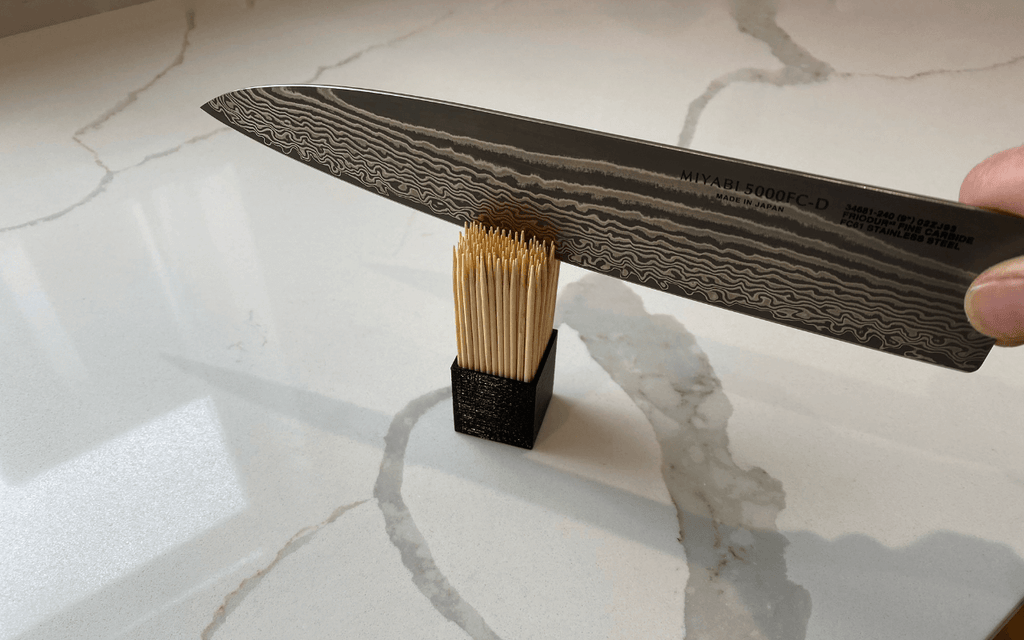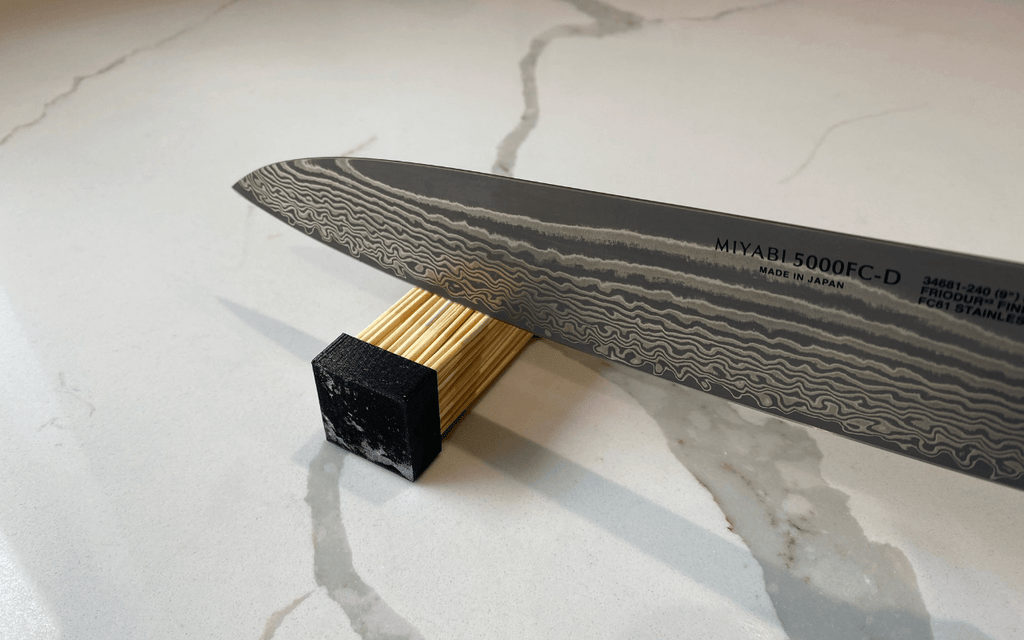Table of Contents
- The Right Wooden Cutting Board For Your Use Case
- What Should I Know About End-Grain Chopping Boards?
- Advantages of an End Grain
- Disadvantages of an End Grain
- What Should I Know About Edge Grain Chopping Boards?
- Advantages of an Edge Grain
- Disadvantages of an Edge Grain
- What Should I Know About Face-Grain Chopping Boards?
- Advantages of a Face Grain
- Disadvantages of an Face Grain
- The Chopping Board Verdict
The Right Wooden Cutting Board For Your Use Case
Let's talk boards. When deciding on the perfect cutting board, the most important thing to consider is what you plan to use it for. Are you a passionate foodie looking for a workhorse to handle heavy dicing? Then you'll want a robust & hard-wearing board that can handle anything. Or maybe you're on the market for a smaller board for some more intricate slicing? Then a lighter board that's easy to clean & store will be your best bet.
What Should I Know About End-Grain Chopping Boards?
By cutting the wood perpendicular to the grain, end-grain cutting boards expose the ends of the wood fibres. This makes for a board that's both beautiful and durable. The real beauty of end-grain cutting boards is that these thicker boards are knife-friendly. Because the wood grain is in the same orientation as the knife blade an end grain cutting board has the amazing ability to heal itself (within reason). What does this mean? End grain boards do not show signs of wear as quickly as edge or face making this style of board both resilient and uniquely striking. They're a great choice for those looking for a durable, dependable workhorse for their kitchen countertop.
Advantages of an End Grain
- Knife-friendly - Extend the time between knife sharpening sessions. End grain boards take care of the blade edge for longer.
- Built to last - Given the unique structure and durability of these boards, they make for a great long-term investment for any kitchen.
- Captivating looks - there's something about the randomised grain pattern that is entrancing and captures attention.
-
One of a kind - The exposed wood fibres on these thicker boards offer a wide range of benefits. They make for a beautiful chopping surface, as well as helping the board repel bacteria.

Disadvantages of an End Grain
- Initially Expensive - Given the craftsmanship and materials that go into making such a robust and unique board, they often come at a premium price point.
- Require upkeep - It's worth noting that these boards do require a small amount of regular maintenance. Applying board balm every so 6 to 8 weeks as a general rule these boards in ship shape.
What Should I Know About Edge Grain Chopping Boards?
If you're looking for a more affordable option, then an edge grain cutting board is the perfect compromise. Edge-grain cutting boards are made from fusing together pieces of wood with the "edge-grain" exposed to the cutting surface. Making the product more budget-friendly because it cuts the manufacturing time in half, but still a robust and sturdy product that looks great and responds wonderfully to daily kitchen use.
Advantages of an Edge Grain
- A more affordable option - Given that they're slightly lighter than end- grain boards, they require less material, labour and thus are a great less expensive option.
- Reliable - Edge grain cutting boards may be slightly less durable than their end-grain counterparts, but they still make for a dependable board. Edge-grain boards are often the backbone of many professional kitchens.
- Easy to clean - Their smooth, hard surface and tight, even grain structure makes them a pleasure to clean & maintain. Clean with a damp cloth and occasionally spend 5 minutes applying board balm to maintain and increase longevity of your board.
Disadvantages of an Edge Grain
- Shortens blade retention - Because they don't boast the exposed fibers that end- grain boards do, knives won't stay sharp as long as they would if using an end grain board. (Don't get us wrong, they'll still last a really long time compared to glass, marble, plastic).
- Prone to wear & tear - These boards will not last indefinitely without signs of wear. Due to the grain running perpendicular to the blade edge. However, you can expect a quality edge grain board that uses a wood species like walnut or maple to last 5 to 10 years.
- Less durable - Often a cost cutting method by the manufacturer is to reduce the thickness, this will shorten the lifespan of your cutting board.
* Caveat! Reducing the thickness of your secondary portable board is a desirable feature, for ease of storage and portability from reduced weight. However, when talking about your primary board you want to shoot for a thickness of 3cm and above.*
What Should I Know About Face-Grain Chopping Boards?
Face-grain boards are made by fusing together long strips of wood, with the face of the grain facing upwards. This creates a beautiful and unique surface which would make a great addition to any style of kitchen. Face-grain boards are visually striking and affordable option that'll do a great job with less demanding slicing and dicing.
Advantages of a Face Grain
- Affordable - The absolute easiest to manufacture making face-grain a good option for those who want the cheapest option.
- Unique - The upwards-facing grain of wood makes for a visually striking surface that would feel at home in any style of kitchen.
Disadvantages of an Face Grain
- Not quite as knife-friendly - Just like edge grain cutting boards you can expect your knives to need sharpening at a slightly more frequent rate.
- Scratch prone - Damage output will be elevated due to the grain direction running perpendicular to the blade edge. Knife cuts will be visible.
- Prone to warping - Because face grain is more chaotic and less structured it's more prone to warping. This can be countered by buying a thicker chopping board.

Edge and face grain boards have grain running perpendicular to the knife which will speed up the tell tale signs of damage faster.
The Chopping Board Verdict
At the end of the day, the perfect board for you depends on what you're looking for. If you want a heavy, robust, and dependable board for repeated and demanding work, an end-grain board is a great option. Quality materials, craftsmanship, and care make it an exceptional choice that will do everything you want it to and more in your kitchen. However, the weight of end-grain boards can make them awkward to move around, and they require a base level of maintenance with mineral oil or board balm to keep them healthy, smooth, and functional.
Or maybe you're after a more affordable option? Then an edge-grain board would be more up your alley and the ideal middle ground or "compromise". The end-grain's little brother is cheaper and often more manoeuvrable, as you can often opt for a thinner version, making it a great option for lighter chopping, slicing, and dicing. But this does come at a cost - their surface is less knife-friendly, meaning that over time your knives will dull and need maintenance earlier. Additionally, these boards are more prone to pesky scratches and nicks from repeated knife use.
If affordability and grain pattern is your top priority? face grain might sound like the best option. These boards make for really striking accessories for any style of kitchen, great for both fashion and function. However, these boards suffer from the same disadvantages as the edge-grain boards. They are often thinner and lighter, however their surface is even more prone to wear and tear and don't make for the most knife-friendly option. But in conclusion, these boards are beautiful and affordable. We use face grain for our charcuterie boards because knife use is minimal, but we have opted not to offer them as a chopping board.
If our boards don't float your boat for whatever reason another popular option is the boos boards which you can find here.




